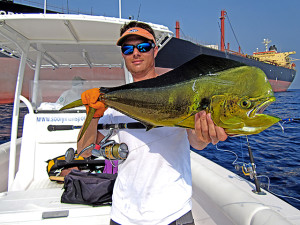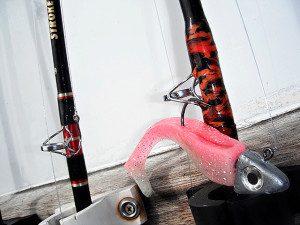Words By: Kit Belen  The dolphinfish (Coryphaena hippurus) has quite a few names; two of the most commonly used are mahi-mahi and dorado. The dolphinfish are surface-dwelling fish found in off-shore temperate, tropical and subtropical waters worldwide. They can grow up to 18 to 20 kilos; however, they seldom exceed 15 kilos, with an average weight of about 7 to 10 kilos. Dolphinfish are probably one of the world’s fastest growing fish and can live up to five years. Probably one of the most colorful off-shore fish you can catch, the pectoral fins of the mahi-mahi are iridescent blue. The flank is broad and golden. Three black diagonal stripes appear on each side of the fish as it swiftly darts after prey. Out of the water, the fish often change colour (giving rise to their Spanish name, dorado, which means “golden”), going through several hues before finally fading to a muted yellow-grey upon death. Mature males (called “bulls”) have prominent foreheads protruding well above the body proper. Females have a rounded head. Females are also usually smaller than males. Humorous fishermen have even given names referring to the size of the fish – smaller mahi-mahi are commonly referred to as “peanuts” while medium-sized ones are called “chickens.” The dolphinfish’s local name is Anfalous. Although present in the Gulf, they are most commonly caught in the east coast, in the Indian Ocean. Where to find Largely offshore fish, they are one of the most curious of fish and usually hang out floating objects out in the middle of the sea. They especially love seaweed and waterlogged trees/branches. In Fujairah, where they are common, they are found around the anchored ships that dot the sea, just outside the harbour.
The dolphinfish (Coryphaena hippurus) has quite a few names; two of the most commonly used are mahi-mahi and dorado. The dolphinfish are surface-dwelling fish found in off-shore temperate, tropical and subtropical waters worldwide. They can grow up to 18 to 20 kilos; however, they seldom exceed 15 kilos, with an average weight of about 7 to 10 kilos. Dolphinfish are probably one of the world’s fastest growing fish and can live up to five years. Probably one of the most colorful off-shore fish you can catch, the pectoral fins of the mahi-mahi are iridescent blue. The flank is broad and golden. Three black diagonal stripes appear on each side of the fish as it swiftly darts after prey. Out of the water, the fish often change colour (giving rise to their Spanish name, dorado, which means “golden”), going through several hues before finally fading to a muted yellow-grey upon death. Mature males (called “bulls”) have prominent foreheads protruding well above the body proper. Females have a rounded head. Females are also usually smaller than males. Humorous fishermen have even given names referring to the size of the fish – smaller mahi-mahi are commonly referred to as “peanuts” while medium-sized ones are called “chickens.” The dolphinfish’s local name is Anfalous. Although present in the Gulf, they are most commonly caught in the east coast, in the Indian Ocean. Where to find Largely offshore fish, they are one of the most curious of fish and usually hang out floating objects out in the middle of the sea. They especially love seaweed and waterlogged trees/branches. In Fujairah, where they are common, they are found around the anchored ships that dot the sea, just outside the harbour.  How to catch. They are perhaps one of the most loved and hated fish in the fishing world, curious and almost always willing biters, the dolphinfish will bite even marlin sized lures and have been known to beat bigger gamefish going after trolled lures. They respond to live bait the most; however, catching them with lures and flies are the most enjoyable. The list of lures, bait and flies that would catch dorado is almost endless, everything from soft plastic baits to heavy metal spoons and jigs, skirted trolling lures to natural bait such as different type of fish and squid will be struck. Oddly enough, I have also seen them take banana peel, gummy bears, chicken and a strip taken from a t-shirt. Before you think they’re the easiest fish to catch in the sea, I have to mention that they are also the most finicky and fickle at times. Especially in heavily pressured areas (such as Fujairah) and going home without a decent fish (which means the bigger and smarter ones) is not uncommon. The best way to catch the bigger ones, which often times are more solitary, is by trolling skirted trolling lures with strips of natural bait. If you are lucky enough to have your own boat, try this technique when moving from fishing location to another. In the case of Fujairah, it’s when you move from one boat to the next, or when you are heading home. The most spectacular way of catching any fish is with a surface lure. Poppers and stickbaits for both fly and conventional fishing will treat you to some spectacular strikes, often very close to the boat. Flies such as Lefty’s deceivers, 3D minnows, DNA Bushpig, Seahabit or any fly designed to mimic squid and baitfish will be taken. Effective colours are pink, white, blue and green. Always remember to use a 15-30cm length of heavy monofilament to act as a bite leader. The dorado has small abrasive teeth that can rub through thin mono. When they are finicky, it is best to drift the boat around the ships and use live bait. We’ve caught them with different baitfish, in Fujairah, they seem to like the small scad/mackerel type bait that also populate the same boats the dorado hunt in. Just to make sure you do catch something, it would be best to catch and stock up on live bait before you head out. When the bite is on with the bait, you can then switch to lures or flies and have even more fun sight casting to them when they start to “boil” around the boat.
How to catch. They are perhaps one of the most loved and hated fish in the fishing world, curious and almost always willing biters, the dolphinfish will bite even marlin sized lures and have been known to beat bigger gamefish going after trolled lures. They respond to live bait the most; however, catching them with lures and flies are the most enjoyable. The list of lures, bait and flies that would catch dorado is almost endless, everything from soft plastic baits to heavy metal spoons and jigs, skirted trolling lures to natural bait such as different type of fish and squid will be struck. Oddly enough, I have also seen them take banana peel, gummy bears, chicken and a strip taken from a t-shirt. Before you think they’re the easiest fish to catch in the sea, I have to mention that they are also the most finicky and fickle at times. Especially in heavily pressured areas (such as Fujairah) and going home without a decent fish (which means the bigger and smarter ones) is not uncommon. The best way to catch the bigger ones, which often times are more solitary, is by trolling skirted trolling lures with strips of natural bait. If you are lucky enough to have your own boat, try this technique when moving from fishing location to another. In the case of Fujairah, it’s when you move from one boat to the next, or when you are heading home. The most spectacular way of catching any fish is with a surface lure. Poppers and stickbaits for both fly and conventional fishing will treat you to some spectacular strikes, often very close to the boat. Flies such as Lefty’s deceivers, 3D minnows, DNA Bushpig, Seahabit or any fly designed to mimic squid and baitfish will be taken. Effective colours are pink, white, blue and green. Always remember to use a 15-30cm length of heavy monofilament to act as a bite leader. The dorado has small abrasive teeth that can rub through thin mono. When they are finicky, it is best to drift the boat around the ships and use live bait. We’ve caught them with different baitfish, in Fujairah, they seem to like the small scad/mackerel type bait that also populate the same boats the dorado hunt in. Just to make sure you do catch something, it would be best to catch and stock up on live bait before you head out. When the bite is on with the bait, you can then switch to lures or flies and have even more fun sight casting to them when they start to “boil” around the boat.
Availability and conservation. As mentioned previously, the dolphinfish can be found in the Gulf; however, they can be readily found and targeted off the coast of Fujairah in the east coast. As a pelagic fish and the lack of research on this specie, it is very difficult to determine the stock of the dolphinfish. However, we do know that there are already some states in the USA limiting the catch rates of this fish. There is also a recommendation to not buy fish from countries that use longlines as longlining increases the risk of catching bycatch while fishing for dolphinfish and other desirable fish.

